

Guide of Slurry Pumps
2019-07-17 09:34:55xinhai
Slurry pumps are mainly responsible for the transportation of mineral slurry in beneficiation processes. And there are many types of pumps in the market. As one of the slurry pump manufacturers, Xinhai has made some improvement on the slurry pump for sale.
Slurry pumps are mainly responsible for the transportation of mineral slurry in beneficiation processes, which plays the role of transportation, feeding,pressurization and discharge. On the one hand, the slurry pump can be used with the mineral processing equipment, such as magnetic separator, flotation machine, screening machine and classification machines; on the other hand, the slurry pump can directly transport the slurry to the designated position through the pipeline.
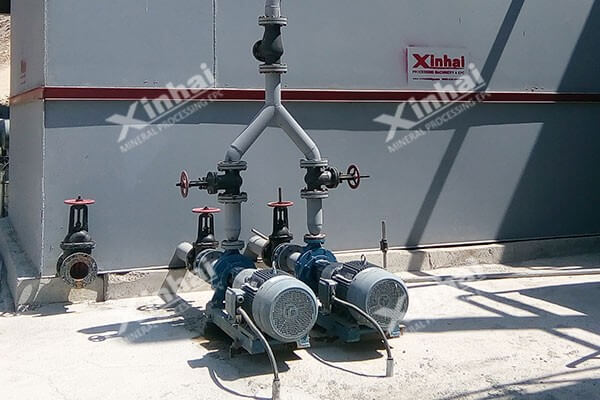
Slurry pump is a kind of pump that is divided based on the medium to be transported.It is a special pump used to transport medium containing solid particles. Slurry pump is widely used in various industrial fields. The medium transported by the slurry pump has strong wear and corrosion, so its service life is generally shorter and the maintenance cost is higher than that of the clean water pump. With the continuous development of technology, the application fields and demand of slurry pumps will continue to expand. The scientific and rational selection of slurry pumps plays a decisive role in actual use effect of the slurry pump. At present, the selection of slurry pumps is focused on the compliance of pure technical parameters, neglecting comprehensive cost analysis of the long-term operation of slurry pumps.
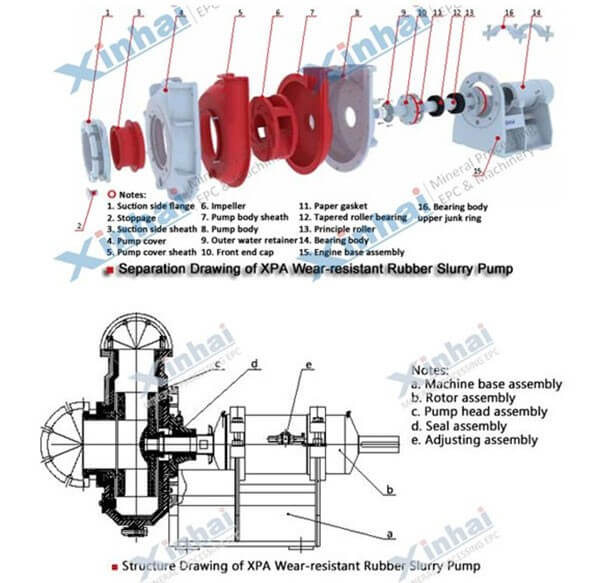
Under the action of centrifugal force, the liquid is thrown from the center of the impeller to the outer edge and obtains energy, leaving the outer edge of the impeller at high speed into the volute casing. In the volute pump case, the liquid is decelerated due to the gradual expansion of the flow passage, and part of the kinetic energy is converted into static pressure energy, and finally flows into the discharge pipe at a relatively high pressure and is sent to a required place. When the liquid flows from the center of the impeller to the outer edge, a certain vacuum is formed at the center of the impeller. Since the pressure above the liquid level of the tank is greater than the pressure at the inlet of the pump, the liquid is continuously pressed into the impeller.
There are various kinds of slurry pumps at present. Generally, slurry pumps can be classified into different types according to their working principles,structure characteristics and applications. It’s recommendable to choose proper slurry pump type in the light of actual conditions of concentrators.
1. Slurry pumps can be divided into single-stage slurry pumps and multi-stage slurry pumps according to the number of impellers.
Single-stage Slurry Pumps:
Single-stage slurry pumps, also named single-stage centrifugal pumps, is a kind of pump with only one impeller. Normally, the single-stage pump has a maximum lift of only 125 meters. It has the characteristics of simple structure, stable performance,high speed, small size, light weight, high efficiency, large flow, easy operation and maintenance.
Multi-stage Slurry Pump:
Multi-stage slurry pumps are usually connected in series and combined by single stage pumps.The output water pressure can be very large. Multi-stage slurry pump is a kind of centrifugal pump, which relies mainly on the rotation of the impeller to obtain centrifugal force, so that the material is pump out when the gas density reach the working range of mechanical vacuum pump and high vacuum is obtained.The multi-stage slurry pump relies on the change of the volume of the pump chamber to achieve the suction, compression and exhaust, and therefore belongs to the variable volume centrifugal pump.
Advantages and disadvantages of single-stage slurry pump and multi-stage slurry pump:
1. Single-stage slurry pump refers to a pump with only one impeller, with a maximum head of 125 meters;
2. Multi-stage slurry pump refers to a pump with two or more impellers, the maximum head can exceed 125 meters; when a single-stage slurry pump lift requires two-stage motors, the multi-stage slurry pump can increase the number of impellers to match the four-stage motor, thus improving the service life of the slurry pump and reducing the noise of the unit. However, the maintenance difficulty of the multi-stage slurry pump is larger than that of the single-stage slurry pump.
3. When the actual head demand of the slurry pump is less than 125 meters, whether a single-stage pump or multi-stage pump is better should be decided according to the pump room area and pump price. Normally, the multi-stage pump is generally more expansive than the single-stage pump)
2. Slurry pumps can be divided into horizontal slurry pumps and vertical slurry pumps according to the position of pump shaft and water level.
Horizontal Slurry Pumps:
The horizontal slurry pump is a centrifugal slurry pump, whose working principle is to transfer the mechanical energy of the prime mover into the liquid by the function of rotating the impeller on the liquid. Since the velocity and pressure energy of the liquid from the inlet to the outlet of the impeller increases, the liquid discharged from the impeller passes through the pressure chamber, and most of the velocity can be converted into pressure energy and then along the drainage pipe. At this time, due to the discharge of the liquid,a vacuum or a low pressure is formed at the inlet of the impeller, and the liquid in the liquid pool is pressed into the impeller inlet under the action of the liquid surface pressure (atmospheric pressure), and the rotary impeller continuously sucks in and discharges the liquid.
Vertical Slurry Pumps:
Vertical slurry pump refers to a device that increases the energy of solid-liquid mixed medium by the action of centrifugal force caused by rotation of the pump impeller. It is widely used in mines, power plants, sulfur, metallurgy,chemical industry, building materials, petroleum and other industry.
Under the action of centrifugal force, the liquid is thrown from the center of the impeller to the outer edge and obtains energy, leaving the outer edge of the impeller at high speed into the volute case. In the volute pump case, the liquid is decelerated due to the gradual expansion of the flow passage, and part of the kinetic energy is converted into static pressure energy, and finally flows into the discharge pipe at a relatively high pressure and is sent to a required place. When the liquid flows from the center of the impeller to the outer edge, a certain vacuum is formed at the center of the impeller. Since the pressure above the liquid level of the tank is greater than the pressure at the inlet of the pump, the liquid is continuously pressed into the impeller.
Advantages and Disadvantages of Horizontal Slurry Pumps and Vertical Slurry Pumps:
1. Appearance:The vertical slurry pump is in a vertical shape, while the horizontal slurry pump is in a horizontal shape;
2. Connection form: The vertical slurry pump is superimposed from bottom to top, and the horizontal slurry pump is arranged vertically on the base. The vertical slurry pump is generally called a pipeline pump such as a vertical pipeline centrifugal pump. The motor and the pump body are connected by a sub-port; the horizontal slurry pump is connected with a motor by a coupling, and needs to be regularly corrected;
3. Floor space: The vertical slurry pump covers a small floor space, while the horizontal slurry pump has a large occupied area. The vertical slurry pump unit also occupies less space than the horizontal slurry pump. The infrastructure of vertical slurry pumps can be determined depending on the production needs. The horizontal slurry pump unit has a base and requires infrastructure.
4. Maintenance difficulty: The vertical slurry pump is difficult to overhaul. For example, it is necessary to remove the upper part of the impeller before it can be repaired; and the horizontal slurry pump is relatively easy to overhaul.
5.Installation form: The vertical slurry pump is connected as a whole, so the installation is easy; while the horizontal slurry pump needs to be adjusted after installation.
3. Slurry pump can be divided into single-suction slurry pump and double-suction slurry pump according to suction water feeding pattern.
Single-Suction Slurry Pump:
The single-suction slurry pump is sucked in horizontal axial direction and discharged radially upward. The pump is of a suspension type. It can exit the rotor parts for maintenance without removing the inlet and outlet pipes during maintenance.The pump is connected with the motor by an ordinary elastic coupling or an extended elastic coupling. The shaft seal of the pump is sealed with a soft packing. The bearings are single row radial ball bearings lubricated with lubricating oil. From the motor side, the pump rotates clockwise. When the single-suction slurry pump is started, the pump shaft drives the impeller to rotate at a high speed, forcing the pre-filling liquid between the blades to rotate. Under the action of inertial centrifugal force, liquid moves radially from the center of impeller to the periphery. The liquid gains energy during the movement through the impeller, the static pressure energy increases, and the flow rate increases. When the liquid leaves the impeller and enters the pump case, it will slow down due to the gradually expanding passageway in the case, and part of the kinetic energy is converted into static pressure energy,and finally flows into the discharge pipe tangentially. Therefore, the volute pump case is not only a component that collects the liquid flowing from the impeller, but also a transducing device. While the liquid is from the center of the impeller to the outer circumference, the center of the impeller forms a low pressure zone. Under the action of the total potential energy difference between the liquid level of the tank and the center of the impeller, the liquid is sucked into the center of the impeller. Rely on the continuous operation of the impeller, the liquid is continuously sucked in and discharged. The mechanical energy obtained by the liquid in the centrifugal pump ultimately manifests as an increase in static pressure energy.
Double-Suction Slurry Pump:
As an important type of centrifugal pump, double-suction slurry pump has been widely used in engineering because of its high lift and large flow. The impeller of this type of pump is actually composed of two back-to-back impeller, from which the flow of water flows into a volute.
The double-suction slurry pump has the following characteristics:
The double-suction slurry pump is equivalent to having two single suction impellers of the same diameter working at the same time, and the flow rate can be doubled under the same outer diameter of the impeller.
The double suction slurry pump casing is opened horizontally, which is convenient for inspection and maintenance. At the same time, its inlet and outlet are in the same direction and perpendicular to the pump shaft, which facilitates the arrangement and installation of the pump and the inlet and outlet pipes.
The impeller of the double-suction slurry pump is symmetrical, has no axial force, and runs smoothly.
Advantages and disadvantages of single-suction slurry pump and double-suction slurry pump:
1.Single-suction slurry pump means that only one end of the impeller enters the water, and the double-suction slurry pump is fed with water at both ends of the impeller, that is, two inlets.
2. The double-suction slurry pump is more suitable for large flow pumping and requires stable operation. When the flow rate of the pump is very high, if a single-suction slurry pump is used, a large pump inlet and outlet diameter are required. At the same time, the rotation speed can’t be very high, and needs to be stabilized at about 1450 rpm. If a double-suction slurry pump is used, the size and weight of the slurry pump can be relatively reduced, the rotational speed can be increased, and the volumetric efficiency can be increased.
3. The anti-cavitation ability of the double-suction slurry pump is stronger than that of the single-suction pump. Since the medium is sucked at both ends of the impeller, hydraulic symmetry is formed, so that the balanced axial thrust of the double suction slurry pump is better than that of the single suction slurry pump, and the operation is more stable. Moreover, the flow rate of the medium is low, and the impeller is not prone to cavitation.
4. The double-suction slurry pump has one more sealing chamber than the single suction slurry pump,so its cost is relatively high.
4. Slurry pumps can be divided into single-shell slurry pump and a double-shell slurry pump according to the structure of pump casing.
The difference between the double-shell slurry pump and the single-shell slurry pump is mainly in the structural forms. The common point is that there are front and rearguard plates and impeller structures. The difference is that the double-shell slurry pump has double-layer structure with a front pump cover and a rear pump cover. When transporting the slurry, the material only passes through the internal over-current components, without contact with the front and rear pumps.And only the internal over-current components need to be replaced, repaired and maintained, so the investment cost can be greatly reduced. The single-shell slurry pump does not have a pump cover.
The mining slurry pump is an indispensable auxiliary equipment in mineral processing plant.It is mainly used for the hydraulic conveying of solid materials such as concentrate, tailings, ash and sediment. However, many mine owners have found that the overcurrent components wear very fast in application due to fluid particle scouring, medium corrosion, cavitation and the like. Therefore, the wear of the slurry pump has always been a challenge to be overcomed for concentrators. Wear-resistant slurry pumps rise in response to the proper time and conditions.
1. XPA Wear-resistant Rubber Slurry Pump
Working principles of XPA wear-resistant rubber slurry pump:
Driven by the motor, the slurry pump and the suction pipeline are filled with slurry before starting the pump. When the impeller rotates at a high speed, energy is transferred to the slurry through the impellers. At the same time, due to the centrifugal force, the slurry moves from the center of the impeller to the outer edge of the impeller, and the conversion of mechanical energy to liquid energy is completed. Through the diffusion of the outlet, the conversion of the kinetic energy and pressure energy of the slurry is realized, and the pressure head of the pump is formed. Meantime, the above process creates a relative vacuum at the center of the impeller, so that the slurry continuously enters the pump chamber under the action of external pressure to complete the slurry transportation.
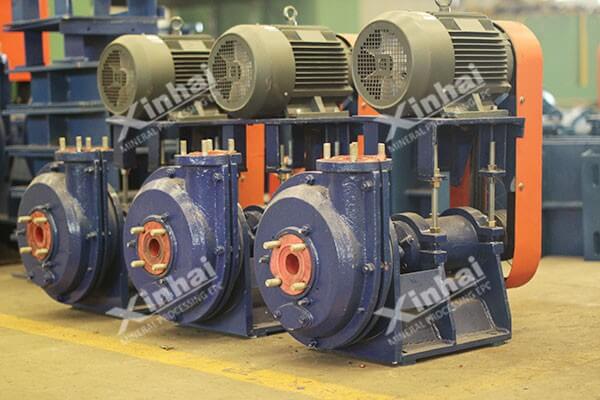
Equipment Characteristics:
Xinhai XPA wear-resistant rubber slurry pump made rubber over-current components by means of the outstanding Xinhai wear-resistant rubber, which has absolute authority in wear resistance;
Different from the metal shell, the rubber lining of the XPA wear-resistant rubber slurry pump has excellent wear resistance, and its good elasticity can also absorb and buffer the impact of the slurry, achieving satisfactory anti-wear effect. In addition, Xinhai XPA wear-resistant rubber slurry pump has other advantages including stable operation, less energy comsumption, low noise, less investment,high efficiency, easy maintenance and durability.
The maximum pumping concentration is not more than 60% by weight;
The temperature of the pumping slurry is 40 ° C to +70 ° C.
Application:
Suitable for pumping corrosive slurries or corrosive fluids containing solid materials, with application exceeding the range of metals and other types of pumps.
Metal smelting plant: hydrocyclone feeding in grinding cycle (including a staged hydrocyclone),the tailings, concentrate and intermediate product pumping, feeding and discharging of thickeners and filters, and pother slurry pumping.
Power plant: tailing ash or slag transportation, coal slurry pumping.
Sand and gravel plant: sand and gravel transportation, sand and water supply in mining,various classification and dewatering equipment, and wear resistance effect is remarkable.
Coal dressing plant: heavy medium classification and screening, coal slurry transportation.
Chemical plant: chemical liquid in low and medium temperature conditions, acid or alkali,slurry, sewage treatment, etc.
Water conservancy projects: damming, river bed silt removal, gravel classification,etc.
Paper mills: clay pulp, pulp and wastewater treatment.
Ceramic and glass plants: porcelain clay and gravel transportation, hydrocyclone feed and wastewater treatment.
Steel plant: conveying of slurry, oxide skin, corrosive liquid, etc.
2. XPAⅡ High Head Wear-resistant Rubber Slurry Pump
Working Principle of XPAⅡ high head wear-resistant rubber slurry pump:
On the basis of the single-stage centrifugal pump, a steep drop head curvet is achieved by means of the principle that the flow rate of the series pump is constant, but pumping head grows longer. After the slurry is pump out through the first-stage impeller, it immediately enters the two impellers to continue to pressurize,thereby obtaining a higher lift. In addition, the radial feed design is adopted, so that the pressure at the sealed box is equivalent to the impeller inlet pressure and at a relatively low pressure, making pump leakage impossible.
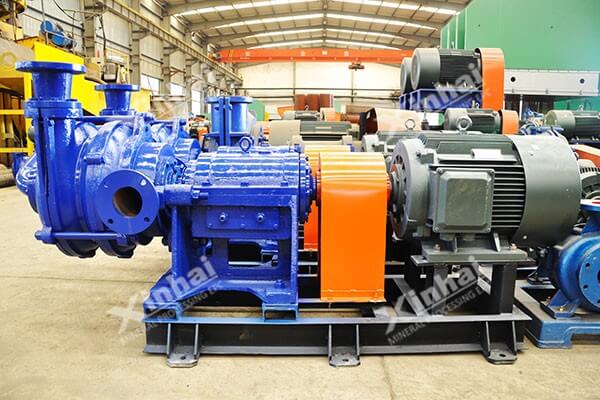
Equipment Characteristics:
XPAII double-stage wear-resistant rubber slurry pump, equipped with Xinhai wear-resistant rubber and standard molded rubber flow-through parts, is a kind of rubber slurry pump with special performance.
Advanced and new hydraulic design and structural design, high efficiency, corrosion resistance, stable and reliable operation.
High Lift, simple and reliable shaft seal, no leakage.
In the filter press industry, the frequency conversion speed regulation will achieve more ideal results, and the pumping concentration is high.
Applications:
In ore dressing plants and chemical plants, XPAII double-stage wear-resistant rubber slurry pump are especially suitable to use as feed stock pressure pump and tailings pump for filter press. It breaks the limitation that the rubber pump can’t be used in working condition with 60 m or more lift required, and expands the application area of rubber pump.
3. XPB Slurry Pump
Working Principles of XPB slurry pump:
Driven by the motor, the suction pipeline is filled with slurry before starting the pump.When the impeller rotates at a high speed, the impeller drives the liquid between the blades to rotate together. By the action of centrifugal force, the liquid is swept from the center of the impeller to the outer edge of the impeller, and the kinetic energy also increases. When the liquid enters the pump case, the flow velocity gradually decreases as the flow path in the volute casing is gradually reduced, and a part of the kinetic energy is converted into static pressure energy, so that the liquid is discharged along the outlet at a relatively high pressure. At the same time, the center of the impeller forms a certain straight space due to the liquid being pumped out, and the pressure at the liquid level is higher than the center of the impeller. Therefore, the liquid in the suction pipeline enters the pump because of the pressure difference. The impeller rotates continuously, and the liquid is continuously sucked in and out.
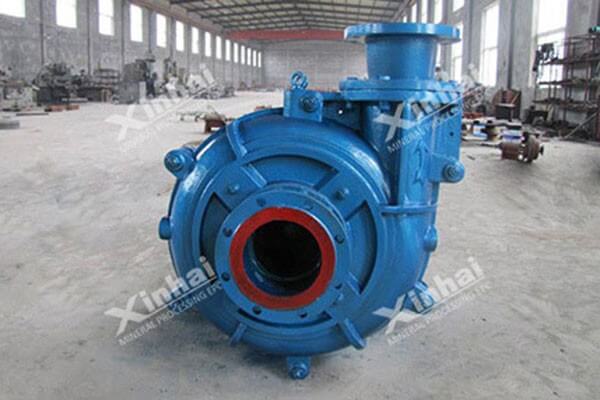
Equipment Characteristics:
Through the theoretical design of solid-liquid two-phase flow, the slurry pump lift can reach 118 m;
The internal structure of this slurry pump is designed reasonably without interference of slurry impact and blockage, which can be applied in various working conditions.
Large diameter, low velocity alloy wear resistant impellers are equipped;
Interchangeable elastomer or metal lining.
Applications:
Applicable to metallurgy, mining, coal, electric power, building materials and other industrial sectors to transport slurry of strong corrosion, high concentration.This type of slurry pump can also be used as multiple stages in series.
Taking the flotation process as an example, the solid-liquid combined raw slurry after grinding will be transported by the slurry pump to classifying equipment such as a hydrocyclone. A part of the concentrate enters into the flotation process, and the flotation concentrate is first transported to the pump box, and then transported to the thickener for dewatering operation through mineral slurry pump. The remaining flotation tailings will be discharged into the tailings pump box, and then discharged to the dry tailings stacking process or directly discharged to the tailings pond by slurry pumps. The slurry pump type selection varies from each stage. An unsuitable slurry pump will greatly reduce the overall operational efficiency of the beneficiation plant and cause loss of the plant. Regarding the choice of mining slurry pump models, we should pay attention to the following aspects.
1. Identify the basic parameters, flow rate, and head of the slurry pump in the process.
The head is the energy a unit weight of fluid obtains by pumping. The flow rate is the amount of slurry liquid that is excluded per unit time. The head and flow rate determine the specific model and size of the slurry pump; it is also necessary to determine the solid-liquid ratio, particle condition and pH value, because it has a high reference value in the model selection of slurry pump.
2. Be clear which process the slurry pump is applied.
After the grinding process, or after the chemical flotation process?Generally, we will consider the wear resistance or corrosion resistance. Relatively speaking,in flotation or other chemical dressing process, the concentrate has less chemical content than that of the tailings, so the corrosion resistance the slurry pump requires when pumping tailings is higher than pumping concentrate. There are other factors. For example, flotation concentrate usually contains a certain proportion of foam, which also affects slurry pump type selection. If the foam content in flotation concentrate is high, a specialized foam slurry pump may be better choice. This slurry pump is specially designed for the flotation process. If the slurry pump is used after hydrocyclone, slurry pump selection is important. The hydrocyclone achieves classification by centrifugal force. The higher the feeding pressure, the higher the slurry flow rate, the greater the rotation speed and centrifugal force of the slurry, the better the classification effect and the production efficiency. And the level of the feeding pressure depends on the slurry pump.
3. Slurry Pump Manufacturer
When choosing a slurry pump manufacturer, we have to consider many factors. As slurry pump is a kind of consumables, a suitable slurry pump manufacturer will bring many benefits to the beneficiation plant. Apart from the basic model matching, the quality of slurry pump is of significance. Wear resistance and corrosion resistance is what we should focus on, because they determines the service life of the slurry pump. When talking about the wear resistance and corrosion resistance, the rubber lining is most important. There are some super wear-resistant linings produced by the some manufacturers whose wear resistance can reach 128%, making a longer service life of slurry pumps. Also, the weight of the lining should be considered, because a lighter lining can increase the rotation speed of the impeller and improve the production efficiency. Of course, sometimes we have to consider some special conditions, such as the temperature conditions of the concentrator. Temperature is also a factor that affects the production efficiency of the slurry pump of the concentrator.
Slurry pump is a common machine that increases the energy of the solid-liquid mixed medium by means of centrifugal force, and slurry pump is mainly used in the fields of mining, metallurgy, construction and the like. As a common practical auxiliary tool, there are some common problems in the use of slurry pumps. This paper summarizes some common problems of the slurry pump and the corresponding solutions. We will explain in detail below.
1. What should I do if the slurry pump flow is unstable?
The reasons for the instability of the slurry pump flow are as follows:
(1) The leaking suction pipe or the bottom valve, or the blocked water inlet is the common cause of insufficient flow in slurry pump. Check the leaking source of the suction pipe and the bottom valve and block it in time, or clean the sludge or blockage at the water inlet.
(2) If the voltage is too low, the speed of the slurry pump will decrease, resulting in insufficient flow of the slurry pump. At this time, the power supply voltage should be checked and adjusted in time.
(3) The pipeline leaks or there is air in the pump body. At this time, the air in the pipeline should be discharged in time.
(4) Serious wear of the seal ring or impeller may also cause the flow rate of the slurry pump to be unstable. The seal ring and impeller of the slurry pump with severe wear should be inspected and replaced in time.
(5) The depth of the bottom valve is insufficient, resulting in air entering during pumping. The depth of the bottom valve should be adjusted according to the suction stroke of the slurry pump.
(6) If the slurry pump starts working for a period of time, but then the current gradually decreases, and the flow is obviously insufficient. This problem still occurs after restarting a normal operation for a period of time, mostly because the slurry or other debris is accumulated in the suction pipe, resulting in cavitation of slurry pump. When the cavitation is serious, the slurry pump will generate a large noise and the pump head will vibrate obviously. At this time,the forebay and suction pipes should be thoroughly cleaned to reduce the length below the elbow, or the agitation device should be added to reduce the slurry sedimentation.
2. What should I do if the slurry pump is cavitation?
At a certain temperature, boiling gasification occurs when the liquid pressure drops below the saturation pressure. This is the characteristic of the liquid itself. At a certain temperature, the saturation gas pressure is constant and increases with rising temperature.
For a centrifugal pump such as a slurry pump, the suction port pressure is lowered to allow the liquid to be sucked into the slurry pump. When the suction port pressure is lower than the saturated air pressure corresponding to the water temperature, the inhaled liquid will undergo a gasification reaction. The bubbles formed by gasification converge at the lowest pressure in the slurry pump, that is, the back of the blade above the impeller inlet. As the surrounding liquid goes outward, noise and vibration are caused by the impact of the liquid. In the long run, the impeller is damaged.
Generally speaking, measures to solve the cavitation phenomenon are:
(1) Control the suction surface pressure to prevent the liquid level pressure from being too low.
(2) Control the flow rate of the suction port to make the slurry pump work under the specified amount.
(3) Properly reduce the installation height of the slurry pump.
(4) The suction valve is open enough and the filter screen is often cleaned.
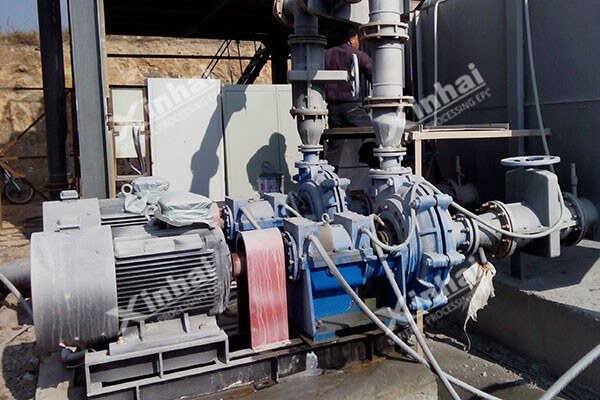
3. What can we do if the slurry pump seal fails?
The reasons why slurry pump seal fails vary in different running stage. We will analyze it in details next.
(1) Slurry pump leaks during installation process.
The slurry pump is prone to problems during the installation process. It is generally necessary to observe whether the slurry pump leaks through the static pressure test. When the leakage is small, there is a problem in the small shifting ring or the static ring sealing ring. If the leakage is large, there are problems with the friction pairs of the moving and stationary rings. The leakage medium is sprayed in the axial direction, which is mostly the problem of the moving ring seal ring. If the leakage medium is sprayed to the periphery or leaks from the water cooling port, it’s probably that the static ring seals have problems.At this time, the slurry pump operation should carefully observe to determine the problem and make adjustment in time.
(2) Slurry pump leaks during trail operation.
After the static test, the leakage of the slurry pump is generally caused by the damage of the friction ring of the moving and stationary rings. There are many reasons for this phenomenon, generally: axial force caused by abnormal phenomena such as cavitation, evacuation, rolling, excessive compression when installing seals, too tight or too loose moving ring seal or static ring seal, or particles in the working medium that enter the friction pair. The main solution is to reassemble the slurry pump and replace the seal.
(3) Slurry pump leaks during normal operation.
In this case, part of leakage is caused by normal wear or the slurry pump reaches the service life, but most of them are caused by changes in working conditions or improper operation and maintenance. The main reasons are: evacuation cavitation or long-time pressure, too small actual output, interrupted seal cooling water,the vehicle is shut down for a long time and the vehicle is restarted, the corrosiveness in the medium is increased, the polymer or the gelatinous substance is increased, and the slurry is increased. The working temperature of the slurry pump changes drastically, and the working conditions are frequently adjusted. In the process of using the slurry pump, it is necessary to pay attention to the specification. Before use, the shaft seal water must be turned on. After the pump is stopped for five minutes, it can be closed. When the slurry pump is stopped for a long time, it is necessary to clean the pump chamber and the machine seal with clean water before stopping the operation. , manually operating the jigger when restarting to extend the service life of the slurry pump.